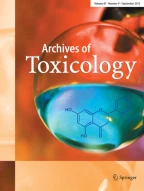Abstract.
The mycotoxin ochratoxin A (OTA) is a rodent carcinogen produced by species of the ubiquitous fungal genera Aspergillus and Penicillium. OTA is found in a variety of food items and as a consequence is also found in human plasma (average concentrations found in this study: 0.1–1 ng OTA/ml plasma). To improve the scientific basis for cancer risk assessment the toxicokinetic profile of OTA was studied in one human volunteer following ingestion of 395 ng 3H-labeled OTA (3.8 µCi). A two-compartment open model consisting of a central compartment was found to best describe the in vivo data. This two-compartment model consisted of a fast elimination and distribution phase (T1/2 about 20 h) followed by a slow elimination phase (renal clearance about 0.11 ml/min.) and a calculated plasma half-life of 35.55 days. This half-life was approximately eight times longer than that determined previously in rats. In addition, the intraindividual fluctuation of OTA plasma levels was investigated in eight individuals over a period of 2 months. The concentrations determined ranged between 0.2 and 0.9 ng OTA/ml plasma. The plasma levels in some individuals remained nearly constant over time, while others varied considerably (e.g. increase of 0.4 ng/ml within 3 days, decrease of 0.3 ng/ml within 5 days) during the observation period. This intraindividual fluctuation in OTA plasma levels, which may represent differences in OTA exposure and/or metabolism, as well as the large difference in plasma half-life in humans compared to rats must be taken into consideration when the results of rat cancer study data are extrapolated to humans for risk assessment purposes.
Similar content being viewed by others
Author information
Authors and Affiliations
Additional information
Electronic Publication
Rights and permissions
About this article
Cite this article
Studer-Rohr, I., Schlatter, J. & Dietrich, D. Kinetic parameters and intraindividual fluctuations of ochratoxin A plasma levels in humans. Arch Toxicol 74, 499–510 (2000). https://doi.org/10.1007/s002040000157
Received:
Accepted:
Issue Date:
DOI: https://doi.org/10.1007/s002040000157
